
PLOT:
Facing a peasant revolt, the king decides to confiscate all the available iron from a poor farming village so that the local blacksmith can forge weapons. The blacksmith, being a sympathetic fellow, hides the iron instead and blames their disappearance on an iron-loving monster named Pulgasari. The king is understandably upset at this news, and decided to imprison and starve the blacksmith until they get the truth. Before his death he fashions a small figurine, which his daughter eventually comes to own (and, eventually, bleed on). Soon, the figurine has (unconvincingly) come to life and begun to eat everything in sight made of iron! UH-OH! Pulgasari grows rapidly from this iron intake and soon helps the villagers as they revolt against the rich king. Eventually the peasants overtake the leaders, but now find themselves at the mercy of Pulgasari who continues to munch on their farming tools. It's up to the blacksmith's daughter to cry, and cry and cry and sacrifice herself for the greater good.
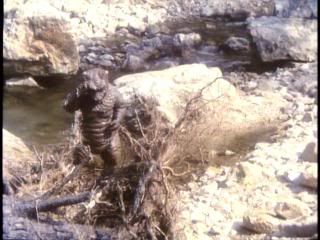
REVIEW:
This may shock you, but Kim Jong Il has been known to get a bit nutty. He's also reportedly a huge fan of movies, particularly Western films, and in the 80s as he was taking over in North Korea as their "Dear Leader" he deemed it incredibly important to kick the North Korean film industry into high gear. Now, he could have opened up film schools or poured money into the technical training of potential filmmakers and eventually produced a solid, internationally renowned cabal of filmmakers (like South Korea has produced since 2000).
But, forget that noise.
Why not, instead, just kidnap a well regarded South Korean director and get him to make movies for North Korea? In 1979, that's exactly what he did, kidnapping Shin Sang-ok and imprisoning him and his wife until they were properly brainwashed and prepared to enter the movie-making machine. Kim Jong Il himself had actually written a book on film-making (he's a renaissance man), and recognized that North Korea needed a bold new vision to introduce themselves to the world cinematic stage.
What was that vision?
A STRANGELY SLOW MOVING AND POLITICAL GODZILLA RIP-OFF.
Thankfully Shin Sang-ok and his wife were able to escape before Pulgasari was complete (which led to his name being removed from the credits), but we're left with a rare artifact that may or may not (opinion seems to vary) have ever actually been screened in North Korea. Have we been denied the North Korean kaiju Godzilla knock-off that we've always wanted?
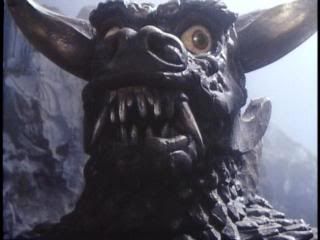
What strikes the viewer very early into Pulgasari is that this is a film with a point to make. Unlike the dozens of Godzilla and Gamera films, which tend to take place in major city centers, this takes place mostly in and around a poor and repressed village in 14th century Korea. There are no spaceships or science fiction elements (except some out-of-place rockets that appear near the end). But it's difficult to watch the film and not try and uncover its political symbolism, particularly in regards to its views on a poor underclass standing up to a military regime and that the monster (representing capitalism?), once a savior of the people, almost ends up destroying them. Or that could all be nonsense, and it might just be a really good excuse to smash up some neat models.
Also, despite the rather limited scope of locations in the film, there are literally thousands of extras onscreen during some of the battle scenes. While not unheard of in epic Hollywood films, the sheer numbers of extras in the film are impressive to witness, though again demonstrates the power of the political machine behind the film's production.
Also, despite the rather limited scope of locations in the film, there are literally thousands of extras onscreen during some of the battle scenes. While not unheard of in epic Hollywood films, the sheer numbers of extras in the film are impressive to witness, though again demonstrates the power of the political machine behind the film's production.
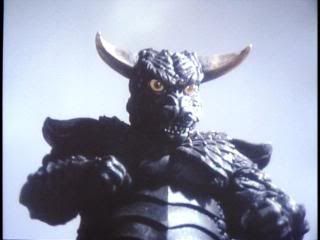
Pulgasari him(her?)self is an imposing creature once he reaches full size, though his early appearances give off an annoying Son Of Godzilla vibe that had me fearing the worst. The suit seems fairly stable, though the blank eyes give their share of unintentional laughs. Staff from Toho actually worked on the special effects of the film, including Kenpachiro Satsuma, the Godzilla actor at the time who also played Pulgasari in the film.
The special effects as a whole are a tad uneven, though there are some impressive miniatures in the second half of the film. The back-projection Pulgasari attacks have aged badly, and certainly there isn't as many lasers or tanks (or skyscrapers) as you would see in an average Godzilla movie, but when models are employed things generally look good.
The special effects as a whole are a tad uneven, though there are some impressive miniatures in the second half of the film. The back-projection Pulgasari attacks have aged badly, and certainly there isn't as many lasers or tanks (or skyscrapers) as you would see in an average Godzilla movie, but when models are employed things generally look good.
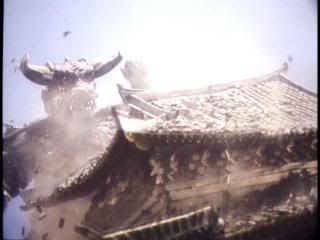
The acting is difficult to gauge, though the subtitles are (thankfully) reasonably coherent. The sets often have a bit of a Shaw Brothers feel to them, with a lot of the village scenes seeming a bit artificial. This artificiality is enhanced by the sound, which appears to be post-synced. Direction is rather flat and the non-Pulgasari action scenes feature inconsistent choreography and sometimes resemble bad 60s sword-and-sandals films. Oddly, the second half of the film feels rather episodic, almost like episodes of a television show rather than a movie, with the military coming up with a plan, almost capturing or killing Pulgasari, and then the monster eventually stopping them.
The film, to my knowledge, has not had a legitimate DVD release in North America. ADV films released the VHS in 2001 (following a successful theatrical release of the film in Japan to combat the 1998 American Godzilla film), and the DVD i've procured may have come from that release. The film is presented full-screen, and the film looks much older than the mid-1980s. While the actual quality of the image is quite good, the film stock makes things appear washed out and bland.
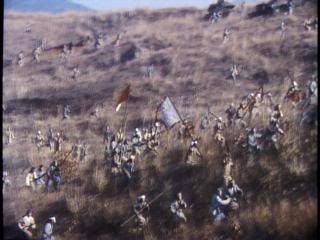
Pulgasari is an interesting historical artifact, and an incredibly wrong-headed attempt to invigorate the North Korean film industry. As is often the case, the story behind the film's creation remains much more interesting than the film itself, though there are enough entertaining moments in the slow moving tale to make it worth seeing. Strangely, Pulgasari (with the help of Shin Sang-ok who eventually sued to get his name put back on the film) was eventually remade in Europe in 1996 as Galgameth.
Fans of kaiju, or for those with an interest in North Korean art and culture, might want to check it out.
Fans of kaiju, or for those with an interest in North Korean art and culture, might want to check it out.
The whole film is actually available on Google Video (and presented here) for anyone interested.










2 comments:
The very fact that this film exists blows my mind.
Have you ever read Kim's book? I've always been curious.
I haven't read the book, but I was reading through the amusing review of "Kim Jong Il on Cinema" here:
http://www.merrillmarkoe.com/writing/main/kim-jong-il-on-cinema-a-book-review/
Here's the best quote related to Pulgasari:
"In closing, it's interesting to note that Mr. Il wrote this book in 1973, five years before he had South Korean director Shin-Sang-ok and his actress wife Choe Eun-hui kidnapped in order to force them to make movies for him. When they finally escaped in 1986 they reported that Mr. Il's personal film library contains 15,000 movies, his favorites being "Friday the Thirteenth," " Rambo" and "James Bond." "
He's a big Friday The 13th fan. Who knew? :)
Post a Comment